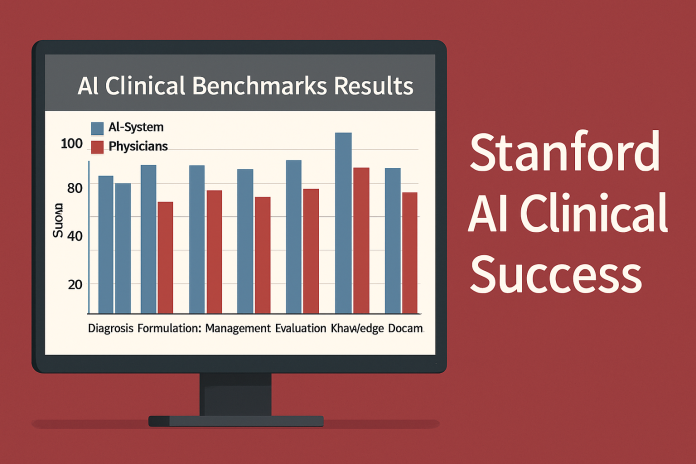Stanford University researchers have created MedAgentBench, the first comprehensive benchmark for clinical AI agents, reaching a 70% success rate in healthcare tasks that physicians typically handle. The Stanford Institute for Human-Centered Artificial Intelligence says this breakthrough tackles a growing global healthcare workforce crisis that could create 10 million job shortages by 2030.
Quick Take
- Stanford’s MedAgentBench tested AI on clinical tasks: achieved 70% success rate
- Kameron Black: AI complements, not replaces, clinical workforces
- AI agents can reduce clinician burnout: addressing global staffing crisis
- FHIR APIs: were key in testing data retrieval and medication ordering
- Global healthcare: faces 10 million worker shortfall by 2030
Researchers at Stanford University are making major strides in artificial intelligence for healthcare by building strict standards and benchmarks for clinical AI deployment. The multidisciplinary team’s work makes sure AI agents can reliably handle tasks similar to human doctors in real-world clinical settings.
“AI won’t replace doctors anytime soon,” said Kameron Black, Clinical Informatics Fellow at Stanford Health Care, stressing AI’s supportive role in clinical workflows.
The research comes as healthcare systems worldwide face unprecedented staffing challenges and record-high burnout rates among medical professionals.
First Comprehensive Clinical AI Evaluation Framework
Stanford’s team built MedAgentBench to evaluate AI agents’ abilities within Electronic Health Record (EHR) environments. The study tested over a dozen language models against real-world clinical challenges, representing the first evaluation framework designed specifically for clinical AI applications.
Jonathan Chen, senior author and Associate Professor, highlights the milestone as progress toward autonomous AI in medical care. The 70% success rate shows AI’s readiness for specific clinical applications while identifying areas that need improvement, particularly workflows demanding nuanced reasoning and system interoperability.
Real-World Testing Through Healthcare Standards
Using Fast Healthcare Interoperability Resources (FHIR) API endpoints, researchers tested AI models’ ability to access and operate within EHRs. Co-author Yixing Jiang noted the benchmark’s role in charting progress and enhancing agent capabilities in authentic healthcare scenarios.
The FHIR integration proved crucial for testing data retrieval and medication ordering capabilities, establishing standardized metrics for healthcare institutions to assess AI readiness before clinical deployment.
Tackling Global Healthcare Workforce Crisis
“Deploying these AI technologies could significantly alleviate staffing shortages,” Black noted, referencing the estimated global healthcare worker shortfall expected to surpass 10 million by 2030. Black, who focuses on clinician burnout solutions, views AI as a teammate rather than replacement.
“I’m passionate about finding solutions to clinician burnout,” he expressed, seeing AI-driven applications as pivotal in reducing workload pressures. Healthcare systems report unprecedented stress levels among medical professionals, with burnout rates reaching record highs across multiple specialties.
Accelerated Timeline for Clinical Adoption
Continued progress with newer AI models shows significant task execution improvements, suggesting earlier-than-expected deployment for basic clinical tasks. Black observed, “Already these tools demonstrate better handling of basic clinical tasks than initially predicted.”
The Stanford team anticipates AI agents being ready for basic task management sooner than expected, marking substantial progress toward real-world adoption. The research establishes a foundation for evaluating future AI systems with standardized assessment protocols.
Strategic Business Implications
The 70% success rate signals AI’s readiness for specific clinical applications, potentially reducing operational costs while improving patient care consistency. Healthcare organizations should prepare for gradual AI integration focused on administrative tasks and basic clinical support rather than complex diagnostic decisions.
Investment in FHIR-compatible systems becomes crucial for organizations planning AI adoption in the next 2-3 years, as interoperability standards prove essential for successful implementation, according to Stanford’s research.






